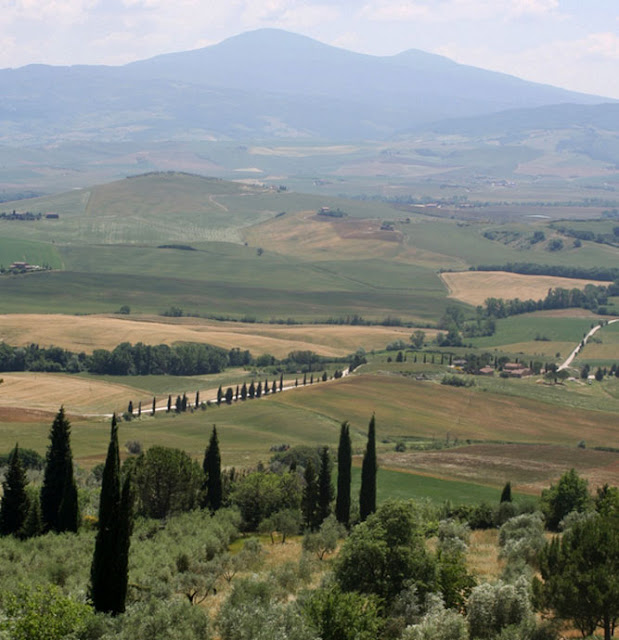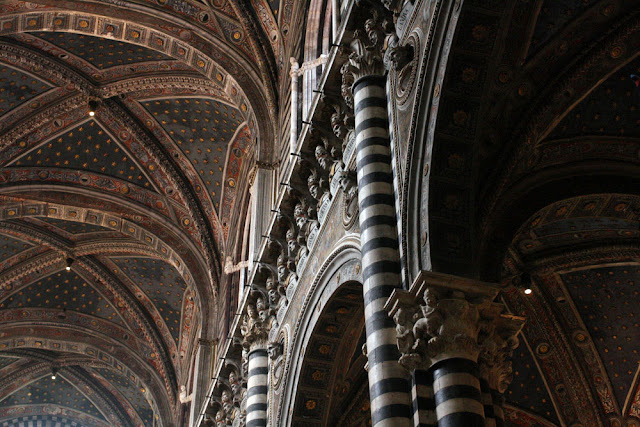Of course, a road trip through Tuscany requires a car. It's never fun to rent a car in the U.S., so it was hardly surprising that renting a car in Italy was a nightmare. It took more than an hour for the Hertz agency in Florence to sort out our pre-booked reservation, and though we had requested the smallest car available, we instead received a monstrous Fiat 500L. With the manual transmission, Ben earned the role of designated driver. Many tourists opt to pick up their rental car at the airport because Florence limits where cars can drive within city limits and the fine totals hundreds of dollars for mistakenly driving in those zones. That meant we couldn't afford to take a wrong turn out of Florence, but aided by Google, Ben handled the traffic flawlessly and we successfully picked up the scenic road to Siena.
One of Tuscany's largest medieval cities, Siena was originally established as a Roman colony by Augustus. It dominated southern Tuscany in the 12th and 13th centuries, controlling trade routes between France and Rome and maintaining Italy’s richest pre-Medici banks. But the Black Death struck in 1348, killing 50%-80% of the population. The city never fully recovered, and in 1557 it became part of Cosimo’s Grand Duchy of Tuscany. Much of medieval Siena still stands today because after its incorporation into the Florentine monarchy, little was built and little demolished. [1]
Siena is divided into 17 contrade, or areas of the city. Originally there were about 59 contrade; only 17 remain today. Each contrada has its own emblems, colors and flags, which are displayed prominently throughout Siena. Every person in Siena is born into a contrada. After dinner, we walked to il campo, the huge brick courtyard that hosts Siena's bi-annual bareback horse race. Known as the Palio, the race features a horse and rider from 10 of Siena's contrade (there's a system for figuring out who gets to compete each year). A thick layer of dirt is laid on the campo, and the horses race around the track three times. Normally the race lasts no more than 90 seconds and the horses commonly throw their jockeys from their backs. [2]
 |
| Duomo di Siena |
The next morning, we toured Siena's Duomo. Built between 1215 and 1263, the Duomo is one of Italy's finest examples of Gothic architecture. The initial architects dreamed of building a church that would dwarf even St. Peter's in Rome. But the Black Death dashed those ambitions, the giant cathedral was never completed and the half-finished walls of the Duomo Nuovo survive as a monument to Siena's former ambition and lost prosperity. [3]
 |
| Statue of Romulus and Remus outside the Duomo di Siena |
We then hopped back in our car for the 25-mile south to Montalcino, a hill town that dates back to Etruscan times. We ate simple sandwiches for lunch at a park overlooking the Tuscan hills.
 |
| View from Montalcino |
After lunch, we checked in to our agriturismo. This place was quite the departure from our normal lodgings — bath robes, tons of pillows, a gourmet breakfast with our own personal espresso pot and best of all, a beautiful pool overlooking vineyards. For the first time all trip, we relaxed for a few hours, swimming, reading and drinking the Vermentino we had bought in town.
In general, we were a bit disappointed by the food in Tuscany and our dinner at Il Giglio in Montalcino was no exception. Plus the atmosphere was a little too stuffy for us. But it probably didn't help that Ben had a cold and couldn't taste anything (poor Ben). On the way home, we stopped briefly to listen to a "music circus," with a band playing 1970s rock hits.
This area of southern Tuscany is famous for its Brunello, a red wine made from Sangiovese grapes grown on the slopes around Montalcino. In hopes of protecting the quality and authenticity of its wine, Italy began developing wine classifications in the 1960s, modeled on the French appellation system. It first created the DOC (Denominazione di Origine Controllata), which created protected zones where vintners must adhere to strict regulations. However, fearing that the DOC certification had grown too lax, Italy introduced a new classification: DOCG (Denominazione di Origine Controllata e Garantita). In 1980, Brunello di Montalcino was awarded the first DOCG designation. [4]
We visited Il Palazzone, a Brunello-producing vineyard in Montalcino. Il Palazzone has to follow the strict rules that govern the production of Brunello. Those rules include: [5]
- Grape variety: 100% Sangiovese Grosso
- Maximum yield: 80 quintals per hectare
- Yield of wine into grapes: 68%
- Required aging: 2 years in oak, 4 months in bottle
- Minimum alcohol content: 12.5%
- Bottling: Can only be performed in the production zone
- Market release: 5 years after the year of harvest
- Color: intense ruby red, tending toward garnet with aging
- Aroma: characteristic fragrance and intense
- Flavor: dry, warm, a little tannic, robust, and harmonious
 |
| Cellar at Il Palazzone |
After our tour and tasting, we stopped for lunch in the town of Pienza and walked around the central square created by the humanist Pope Pius II to demonstrate urban planning concepts and the principles of perfect design.
Our tour of Tuscany complete, it was time to drive to Orvieto and drop off the car. We had two options: the autostrada or a state highway, both of which were supposed to take the same amount of time. We chose the more scenic state highway and were enjoying the drive until ... the road ended. There was no warning, nothing. It appears as if they failed to build the final mile connecting the two halves of the road. Of course it's possible that we missed a sign in Italian, but the whole time, we kept seeing signs that said we were headed to Rome, even though the road to Rome hadn't been built yet.
 |
| Cable car in Orvieto |
The detour took a solid two hours, causing us to miss our train. Luckily, we had allocated plenty of time, dropped off our car, and took the cable car in Orvieto up to the old city to grab a bite.
Then we hopped on the next train to our final destination: Rome.
- Steph
Sources:
[1] Rough Guide Italy
[2] Discovery Tuscany, "The Palio in Siena"
[3] Sacred Destinations, "Siena Duomo"
[4] The Kitchn, "What's the Difference? DOCG, DOC, and IGT Italian Wines"
[5] Montalcino Report, "Brunello di Montalcino production regulations"














No comments:
Post a Comment
All comments are moderated before publishing. Comments with links (unless directly relevant to the post) will not be approved. No spam, please.